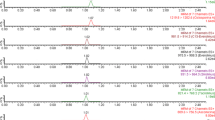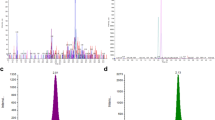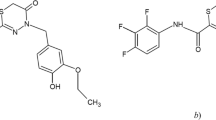Abstract
Monitoring of Cyclosporine A (CsA) concentrations in whole blood is widely performed due to the narrow therapeutic index of the drug. Required standardisation for routine analysis of CsA is still missing. The candidate reference measurement procedure presented here is designated for the assignment of CsA values in hemolysed blood associated with expanded measurement uncertainty. Separate stock solutions for calibration and control materials were prepared by spiking hemolysed blood with CsA under gravimetric control. The essential sample pretreatment step was protein precipitation. Analysis was performed using isotope dilution LC-MS/MS with online solid phase extraction. Interference by matrix components was investigated. Using [2H4]-CsA as the internal standard, no interference from the investigated matrices were detected. Measurement repeatability using three pools of whole blood as samples revealed coefficients of variation (CV) ranging from 1.0 % to 1.6 %. Intermediate measurement precision was determined by repeated analysis of self-prepared control materials taken from different stock solutions of pooled whole blood. CVs were between 0.8 % and 2.4 %. Measurement accuracy was checked using three control materials prepared from three different stock solutions. The recoveries of the mean of mean values obtained on four measurement days ranged from 99.4 % to 101.3 %. The combined expanded uncertainty of measurement based on 5 days of measurement and was evaluated according to the GUM as U = 2.0 % (k = 2).




Similar content being viewed by others
References
Borel JF, Feurer C, Gubler HU et al (1976) Biological effects of cyclosporin A: a new antilymphocytic agent. Agents Actions 6:468–475
Calne RY, White DJ, Thiru S et al (1978) Cyclosporin A in patients receiving renal allografts from cadaver donors. Lancet 2:1323–1327
Olyaei AJ, de Mattos AM, Bennett WM (2001) Nephrotoxicity of immunosuppressive drugs: new insight and preventive strategies. Curr Opin Crit Care 7:384–389
Shaw LM, Holt DW, Keown P et al (1999) Current opinions on therapeutic drug monitoring of immunosuppressive drugs. Clin Ther 21:1632–1652
Armstrong VW, Oellerich M (2001) New developments in the immunosuppressive drug monitoring of cyclosporine, tacrolimus, and azathioprine. Clin Biochem 34:9–16
Lemaire M, Tillement JP (1982) Role of lipoproteins and erythrocytes in the in vitro binding and distribution of cyclosporin A in the blood. J Pharm Pharmacol 34:715–718
Brocks DR, Ala S, Aliabadi HM (2006) The effect of increased lipoprotein levels on the pharmacokinetics of cyclosporine A in the laboratory rat. Biopharm Drug Dispos 27:7–16
Seger C, Vogeser M (2010) Immunosuppressant drug monitoring: a routine undertaking? J Lab Med 34:117–128
Wallemacq P, Maine GT, Berg K et al (2010) Multisite analytical evaluation of the abbott ARCHITECT cyclosporine assay. Ther Drug Monit 32:145–151
Steimer W (1999) Performance and specificity of monoclonal immunoassays for Cyclosporine Monitoring: how specific is it? Clin Chem 45:371–381
Taylor PJ (2004) Therapeutic drug monitoring of immunosuppressant drugs by high-performance liquid chromatography-mass spectrometry. Ther Drug Monit 26:215–219
Koster RA, Dijkers ECF, Uges DRA et al (2009) Robust, high-throughput LC–MS/MS method for therapeutic drug monitoring of cyclosporine, tacrolimus, everolimus, and sirolimus in whole blood. Ther Drug Monit 31:116–125
Seger C, Tentschert K, Stöggl W et al (2009) A rapid HPLC–MS/MS method for the simultaneous quantification of cyclosporine A, tacrolimus, sirolimus and everolimus in human blood samples. Nat Protoc 4:526–534
Ceglarek U, Lembcke J, Fiedler GM et al (2004) Rapid simultaneous quantification of immunosuppressants in transplant patients by turbulent flow chromatography combined with tandem mass spectrometry. Clin Chim Acta 346:181–190
ISO 15193:2009 (2009) In vitro diagnostic medical devices—measurement of quantities in samples of biological origin—requirements for content and presentation of reference measurement procedures, 2nd ed
ISO 15195:2003 (2003) Laboratory medicine—requirements for reference measurement laboratories, 1st ed
Streit F, Armstrong VW, Oellerich M (2002) Rapid liquid chromatography-tandem mass spectrometry routine method for simultaneous determination of sirolimus, everolimus, tacrolimus and cyclosporin A in whole blood. Clin Chem 48:955–958
Salm P, Taylor PJ, Lynch SV et al (2005) A rapid HPLC–mass spectrometry cyclosporin method suitable for current monitoring practices. Clin Biochem 38:667–673
Levine DM, Maine GT, Armbruster DA et al (2011) The need for standardization of tacrolimus assays. Clin Chem 57:1739–1747
ISO/IEC Guide 98-3:2008 (2008) Uncertainty of measurement—Part 3: Guide to the expression of uncertainty in measurement (GUM:1995), 1st ed
Stokvis E, Rosing H, Beijnen JH (2005) Stable isotopically labeled internal standards in quantitative bioanalysis using liquid chromatography/mass spectrometry: necessity or not? Rapid Commun Mass Spectrom 19:401–407
Matuszewski BK, Constanzer ML, Chavez-Eng CM (2003) Strategies for the assessment of matrix effect in quantitative bioanalytical methods based on HPLC–MS/MS. Anal Chem 75:3019–3030
Taylor PJ (2005) Matrix effects: the Achilles heel of quantitative high-performance liquid chromatography–electrospray–tandem mass spectrometry. Clin Biochem 38:328–334
Annesley TM (2003) Ion suppression in mass spectrometry. Clin Chem 49:1041–1044
Little J, Wempe M, Buchanan C (2006) Liquid chromatography–mass spectrometry/mass spectrometry method development for drug metabolism studies: examining lipid matrix ionization effects in plasma. J Chromatogr B 833:219–230
Sherman J, McKay MJ, Ashman K et al (2009) How specific is my SRM?: the issue of precursor and product ion redundancy. Proteomics 9:1120–1123
Becker S, Thiery J, Ceglarek U (2013) Evaluation of a novel commercial assay for the determination of cyclosporine a, tacrolimus, sirolimus, and everolimus by liquid chromatography–tandem mass spectrometric assay. Ther Drug Monit 35:129–132
Ansermot N, Fathi M, Veuthey J-L, Desmeules J, Rudaz S, Hochstrasser D (2008) Simultaneous quantification of cyclosporine, tacrolimus, sirolimus and everolimus in whole blood by liquid chromatography–electrospray mass spectrometry. Clin Biochem 41:728–735
Meinitzer A, Gartner G, Pilz S, Stettin M (2010) Ultra fast liquid chromatography–tandem mass spectrometry routine method for simultaneous determination of cyclosporin A, tacrolimus, sirolimus, and everolimus in whole blood using deuterated internal standards for cyclosporin A and everolimus. Ther Drug Monit 32:61–66
Guideline for quality control in forensic-toxicological analyses. German Society of Toxicological and Forensic Chemistry (GTFCh) (2009) Scientific Committee Quality Control, 1st ed
ISO 15194:2009 (2009) In vitro diagnostic medical devices—measurement of quantities in samples of biological origin—requirements for certified reference materials and the content of supporting documentation, 2nd ed
Acknowledgments
This study was financially supported by Reference Institute for Bioanalytics (RfB), Foundation for Pathobiochemistry and Molecular Diagnostics, Bonn, Germany.
Conflict of interest
There is no conflict of interests regarding the publication of this article. Research funding had no influence on the study design.
Author information
Authors and Affiliations
Corresponding author
Rights and permissions
About this article
Cite this article
Grote-Koska, D., Czajkowski, S., Klauke, R. et al. A candidate reference measurement procedure for Cyclosporine A in whole blood. Accred Qual Assur 19, 147–157 (2014). https://doi.org/10.1007/s00769-014-1048-5
Received:
Accepted:
Published:
Issue Date:
DOI: https://doi.org/10.1007/s00769-014-1048-5




